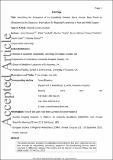Identifying the emergence of the superficial peroneal nerve through deep fascia on ultrasound and by dissection : implications for regional anaesthesia in foot and ankle surgery
Abstract
Regional anesthesia relies on a sound understanding of anatomy and the utility of ultrasound in identifying relevant structures. We assessed the ability to identify the point at which the superficial peroneal nerve (SPN) emerges through the deep fascia by ultrasound on 26 volunteers (mean age 27.85 years ± 13.186; equal male: female). This point was identified, characterized in relation to surrounding bony landmarks (lateral malleolus and head of the fibula), and compared to data from 16 formalin‐fixed human cadavers (mean age 82.88 years ± 6.964; equal male: female). The SPN was identified bilaterally in all subjects. On ultrasound it was found to pierce the deep fascia of the leg at a point 0.31 (±0.066) of the way along a straight line from the lateral malleolus to the head of the fibula (LM‐HF line). This occurred on or anterior to the line in all cases. Dissection of cadavers found this point to be 0.30 (±0.062) along the LM‐HF line, with no statistically significant difference between the two groups (U = 764.000; exact two‐tailed P = 0.534). It was always on or anterior to the LM‐HF line, anterior by 0.74 cm (±0.624) on ultrasound and by 1.51 cm (±0.509) during dissection. This point was significantly further anterior to the LM‐HF line in cadavers (U = 257.700, exact two‐tailed P < 0.001). Dissection revealed the nerve to divide prior to emergence in 46.88% (n = 15) limbs, which was not identified on ultrasound (although not specifically assessed). Such information can guide clinicians when patient factors (e.g., obesity and peripheral edema) make ultrasound‐guided nerve localization more technically challenging.
Citation
Bowness , J , Turnbull , K , Taylor , A , Halcrow , J , Chisholm , F , Grant , C & Varsou , O 2019 , ' Identifying the emergence of the superficial peroneal nerve through deep fascia on ultrasound and by dissection : implications for regional anaesthesia in foot and ankle surgery ' , Clinical Anatomy , vol. 32 , no. 3 , pp. 390-395 . https://doi.org/10.1002/ca.23323
Publication
Clinical Anatomy
Status
Peer reviewed
ISSN
0897-3806Type
Journal article
Collections
Items in the St Andrews Research Repository are protected by copyright, with all rights reserved, unless otherwise indicated.

